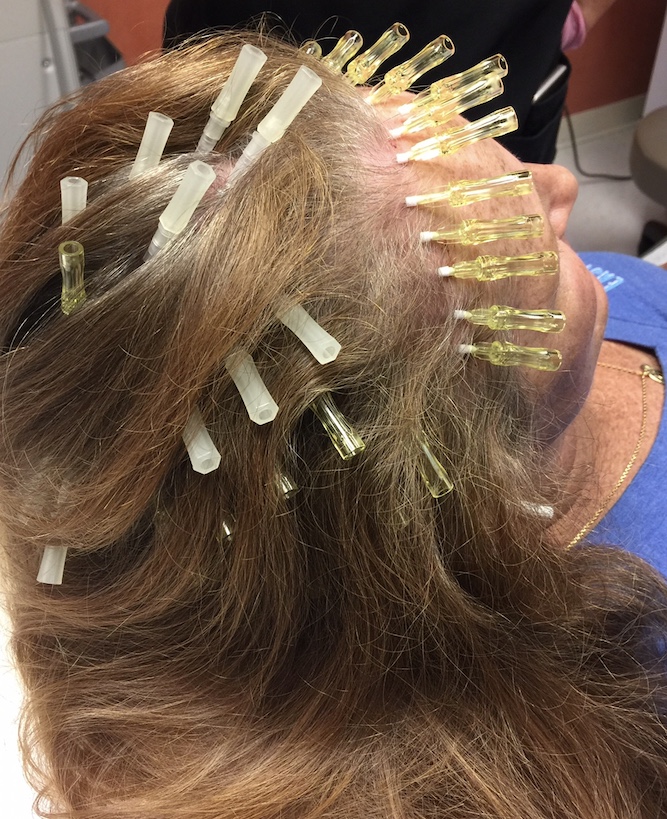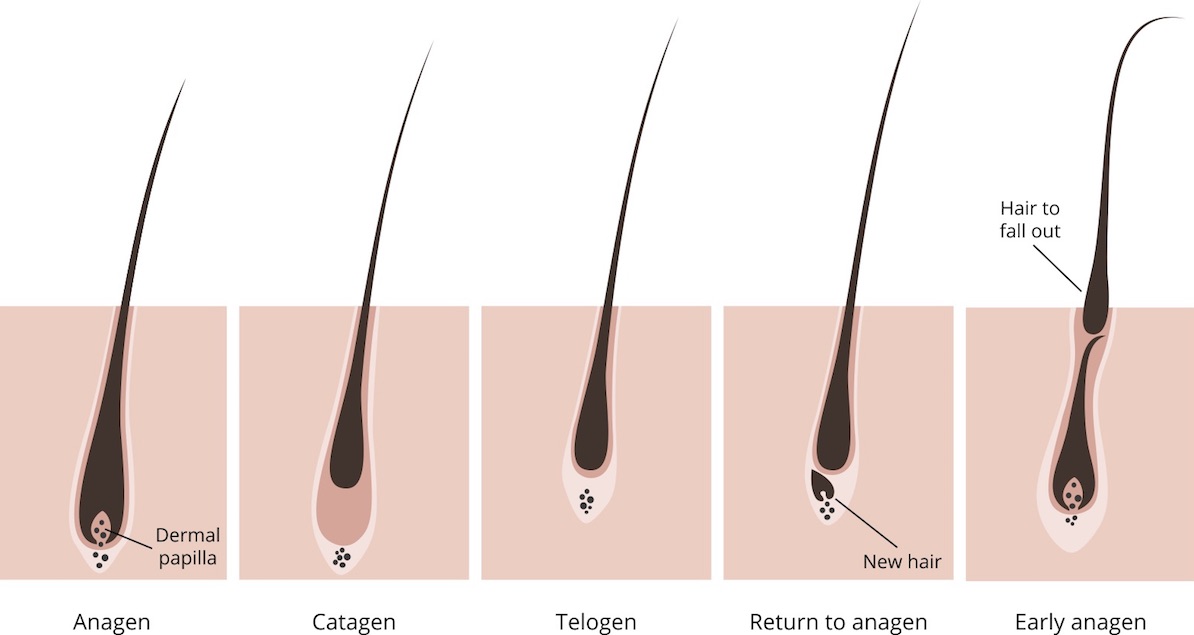Elizabeth Leapley of Indialantic worried she might have lost her hair from chemo and radiation after a double mastectomy.
She needn’t have, for Leapley’s locks returned as luxurious as ever. “It grew back as I remembered it,” she said.
Leapley, a flight attendant for 25 years, is particularly conscious about her hair, for her job affords her a unique perspective. “I have a bird’s eye view of the top of the passengers’ heads, so I see women with hair so thin you can look through to their scalps,” she said.
Everything was fine for Leapley until about 21 months ago, when she started noticing her hair inexplicably thinning and falling out.
“I used to need a large banana clip to hold up all my hair, but for some reason, a medium to small clip would do the job,” she said.
Thinning hair was not part of the professional picture Leapley wanted to reflect. “My job as a flight attendant, right after safety and security, is to have a polished, professional appearance that represents my company well,” she said. “My outward appearance to the public is central to my overall self-confidence. I can hide breast cancer behind surgeries or behind my uniform, but unless I wear a wig or extensions, my thinning hair is out there on display for the flying public to see.

“When I’m going through the [pre-flight] safety demo, I wonder if my passengers are focused on my demo or looking at my thinning hair,” she said.
Panic began to set in.
“My part was widening, my scalp could be seen fully under certain lighting conditions and my hairline along my temple was noticeably receding,” Elizatbeth said.
“Every day there was more and more hair on the sink counter, the shower and in my brush.”
She methodically began to document her hair loss, gathering hair in Dixie cups as evidence, and employed an arsenal of hair products, scalp treatments and minoxidil (branded under Rogaine, this is a vasodilator that can treat certain types of baldness when applied topically). “In the back of my mind, I wondered if I would run out of hair before I ran out of these products,” she said.
As part of her cancer treatment, Leapley needed estrogen-blocking medication that, unfortunately, includes hair loss and thinning hair as side effects. Her hair loss may also have been abetted by genetics. “I remember my mom had thin hair, especially as she got older, and my sister has very thin hair and so did my father,” she said.
Genetics may indeed dispose her to alopecia, the term given to thinning hair in certain areas of the scalp, and can lead in extreme cases to total hair loss.
Other contributing factors, stress among the most apparent, also probably contributed.
“In both my personal and professional life, there is inherent stress as a single mom, cancer survivor, post-menopausal aged woman and as flight attendant constantly on the go, especially in this era of COVID-19,” she said.
While male pattern baldness receives most of the press, hair loss is not limited to men.
According to the Cleveland Clinic, more than 50% of women will experience noticeable hair loss, and female-pattern hair loss, or FPHL, affects 30 million women in the U.S. The issue is most common after childbirth, and advancing age, stress, surgeries, diet, some medications, genetics and even harsh hair chemicals and hairstyles (such as ponytails) can also all be culprits.
Everyone loses hair at the rate of 50 to 100 single strands per days, but as some hair falls, others grow to balance things out. When more hair falls out than grows back, that’s when it’s time to take action, as Elizabeth did.
She found an ally against hair loss in Dr. Emran Imami, who also happened to be her breast cancer surgeon. Part of his practice includes Imami Skin & Cosmetic Center, which offers hair restoration services such as PDO threads, often combined with Protein Rich Plasma, or PRP, injections.

The procedure involves series of tiny needles, preloaded with the threads, inserted into the scalp to direct the thread beneath the numbed skin, where they remain to work their magic. It may sound painful, but it is not, according to patients, who say they experience a mild heaviness on their head, but the feeling disappears by the next day. PRP can be done simultaneously with the PDO threads. Several syringes of the “liquid gold” platelet plasma are injected into areas where regrowth is desired.
There is no downtime for either procedure.
PDO, the acronym for Polydioxanone, has been a staple in aesthetics for several years as a non-surgical facelift and wrinkle controller. Thinner in circumference than a strand of hair, PDO threads consist of protein that help to relax tendons and muscles in the area of insertion while simultaneously improving blood flow. By triggering inflammatory response, they encourage new blood vessels to stimulate hair growth. Because the new hair is thicker, it will not break as easily.
“PDO threads help increase vascularity and lead to a healthier hair follicle,” said Dr. Imami. “It should enhance hair growth, hair retention, hair thickness and hair durability.”
Research studies have noted that with PDO, patients experienced a regrowth rate increase from an average of 65 follicles per centimeter to 93. Although women are currently more drawn to PDO threads than men, both can benefit from the treatment.
“Men often have androgenic hair loss, or male pattern baldness, which at advanced stages can only be remedied with hair transplantation, but having said that, anyone with thin hair shafts or decreased hair density would benefit from the PDO scalp treatment,” said Dr. Imami.
Can PDO threads reverse hair loss? Sort of.
“By stimulating the hair follicle and increasing vascularity, PDO threads will reverse the process of hair miniaturization,” he explained. “This in effect will slow down both hair thinning and hair loss.”
The procedure works best when combined with injections of Protein Rich Plasma, he continued.
“PRP treatments help in creating healthier hair follicles by applying concentrated growth factors directly into the scalp.”
“This is a different mechanism of action than the PDO threads that create subtle inflammation and stimulate new blood vessel growth. Both treatments can be used simultaneously for optimal effect.”
For an added boost, Dr. Imami recommends a combination therapy that also includes topical medications such as minoxidil, supplements such as biotin, special herbal shampoos, particularly those with red clover extract, and low-level laser therapy. Results will appear, but over time, given the fact that scalp hair grows slowly and has a dormancy period that can encompass several months.“PRP treatments as well as the PDO treatments usually take four to six months to see improvement,” he said. However, The treatment is also not a one-shot deal.

“PDO threads take approximately six months before they completely dissolve, and since hair naturally thins with age, I recommend repeating PDO thread placement every six months for optimal effect,” he said.
PRP requires an initial set of three injections spaced a month apart and maintenance treatment as needed.
When new growth appeared in thinning areas of her scalp, Elizabeth said she was overjoyed and committed to continuing with treatment. “I was skeptical at first, but after a while, I was encouraged to see new hair growing… I have no doubt my hair will continue to increase in volume, coverage, density and appearance, but like anything that truly works, it must be maintained with regular treatments.”
“What do you have to lose, except more hair?” said Leapley.
For more information, call 321-312-4168 or visit imamihair.com.
A Brief History of the Hair Follicle

Humans are blessed with approximately 100 hair follicles per centimeter. The follicles have a rather active lifestyle through anagen, or its growing, phase, which can last from two to eight years and include about 90% of the hair on the head.
In the two- to three-week transition phase known as catagen, hair follicles shrink before heading to the telogen phase, the resting time for hair, which encompasses two to four months and signals the last chapter in the follicles lifespan before they fall out.
Everything with hair happens slowly, and because there are so many follicles to begin with, it can take years before significant loss is noticed as hair strands thin more, remain dormant for longer and slow their regrowth until they stop growing altogether.
“You can lose up to 75 of the 100 hair follicles per centimeter and still not look bald,” said Dr. Emran Imami of Imami Skin & Cosmetic Center.
The trick is to treat thinning hair while the follicles are still around, even in a debilitated state. Once they are gone, they are gone, and the only option is a transplant. “The goal is to maximize the growth phase of the hair cycle and to make the hair on the head last longer, because the net effect is more hair density,” said Dr. Imami.

Maria Sonnenberg
Maria is a prolific writer and proofer for Space Coast Living and an adjunct professor at Florida Institute of Technology’s Nathan M. Bisk College of Business. When not writing, teaching or traveling, she can be found waging a one-woman war against her lawn and futilely attempting to maintain order among the chaos of a pack of extremely clueless wirehair dachshunds and an angst-driven basset hound.




